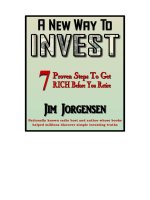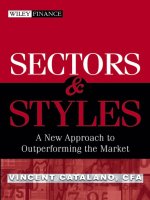Joe ross spreads a whole new way to trade
Bạn đang xem bản rút gọn của tài liệu. Xem và tải ngay bản đầy đủ của tài liệu tại đây (237.9 KB, 10 trang )
SPREADS – A WHOLE NEW WAY TO TRADE
What Is a Spread?
Spread trading in futures is as old as the hills, yet it is an entirely new concept for
most current traders in futures. In this introductory piece, we will show you that
spreads can be the most conservative, safest way to trade in the futures markets.
But first, what exactly is a spread?
A spread is defined as the sale of one or more futures contracts and the purchase
of one or more offsetting futures contracts. You can turn that around to state that a
spread is the purchase of one or more futures contracts and the sale of one or
more offsetting futures contracts. A spread is also created when a trader owns (is
long) the physical vehicle and offsets by selling (going short) futures.
Furthermore, a spread is defined as the purchase and sale of one or more offsetting
futures contracts normally recognized as a spread by the fact that the two sides of
the spread are actually related in some way. This explicitly excludes those exotic
spreads put forth by some vendors, which are nothing more than computer
generated coincidences which are not in any way related. Such exotic spreads as
Long Bond futures and Short Bean Oil futures may show up as reliable computer
generated spreads, but bean oil and bonds are not really related. Such spreads fall
into the same category as believing the annual performance of the U.S. stock market
is somehow related to the outcome of the Super Bowl sporting event.
In any case, for tactical reasons in carrying out a particular strategy, you want to
end up with:
1. simultaneously long futures of one kind in one month, and short futures of
the same kind in another month. (Intramarket Calendar Spread)
2. simultaneously long futures of one kind, and short futures of another kind.
(Intermarket spread)
3. long futures at one exchange, and short a related futures at another
exchange. (Inter-exchange Spread)
4. long an underlying physical commodity, and short a futures contract.
(Hedge)
5. long an underlying equity position, and short a futures contract. (Hedge)
6. long financial instruments, and short financial futures. (Hedge)
The primary ways in which this can be accomplished are:
•
Via an Intramarket spread.
•
Via an Intermarket spread.
•
Via an Inter-exchange spread.
•
By ownership of the underlying and offsetting with a futures
contract.
Intramarket Spreads
Officially, Intramarket spreads are created only as calendar spreads. You are long
and short futures in the same market, but in different months. An example of an
Intramarket spread is that you are Long July Corn and simultaneously Short
December Corn.
Intermarket Spreads
An Intermarket spread can be accomplished by going long futures in one market,
and short futures of the same month in another market. For example: Short May
Wheat and Long May Soybeans.
Intermarket spreads can become calendar spreads by using long and short futures in
different markets and in different months.
Inter-Exchange Spreads
A less commonly known method of creating spreads is via the use of contracts in
similar markets, but on different exchanges. These spreads can be calendar spreads
using different months, or they can be spreads in which the same month is used.
Although the markets are similar, because the contracts occur on different
exchanges they are able to be spread. An example of an Inter-exchange calendar
spread would be simultaneously Long July Chicago Board of Trade (CBOT) Wheat,
and Short an equal amount of May Kansas City Board of Trade (KCBOT) Wheat. An
example of using the same month might be Long December CBOT Wheat and Short
December KCBOT Wheat.
Why Spreads?
The rationale behind spread trading is one of the best-kept secrets of the insiders of
the futures markets. While spreading is commonly done by the market “insiders,”
much effort is made to conceal this technique and all of its benefits from “outsiders,”
you and me. After all, why would the insiders want to give away their edge? By
keeping us from knowing about spreading, they retain a distinct advantage.
Spreading is one of the most conservative forms of trading. It is much safer than
the trading of outright (naked) futures contracts. Let’s take a quick look at some of
the benefits of using spreads:
1. Intramarket spreads require considerably less margin, typically around 25% 75% of the margin needed for outright futures positions.
2. Intramarket spreads offer a far greater return on investment than is possible
with outright futures positions. Why? Because you are posting less margin
for the same amount of possible return.
3. Spreads, in general, trend more often than outright futures.
4. Spreads are often trending when outright futures are flat.
5. Spreads can be filtered by virtue of seasonality, backwardation, and carrying
charge differentials, in addition to any other filters you might be using in your
trading.
6. Spreads can be used to create partial futures positions. In fact, virtually
anything that can be done with options on futures can be accomplished via
spread trading.
7. Spreads allow you to take less risk than is available with outright futures
positions. The amount of risk between two Intramarket futures positions is
usually less than the risk in an outright futures position. The risk between
owning the underlying and holding a futures contract involves the least risk of
all. Spreads make it possible to hedge any position you might have in the
market. Whether you are hedging between physical ownership and futures,
or between two futures positions, the risk is lower than that of outright
futures. In that sense, every hedge is a spread.
8. Spread order entry enables you to enter or exit a trade using an actual spread
order, or by independently entering each side of the spread (legging in/out).
9. Spreads are one of the few ways to obtain decent fills by legging in/out during
the market Closing.
10. Live data is not needed for spread trading, saving you $$ in exchange fees.
11. You will not be the victim of stop running when using Intramarket spreads.
What Can You Expect?
Here are some examples of what you can expect from Intramarket spread trading.
We think you may be pleasantly surprised!!
Margin for this trade was $250. Margin for an
outright soybean trade would have been $950.
Exit
We entered a soybean spread at a
value of 1. We exited at a value of 11.
Result 10 points, $500 in profits.
Would you want to have been long soybeans during this same period??
Although you would have made money on the trade, you would have suffered from
serious whipsaw during the entire length of the trade.
At one point, there was a major draw-down on your margin account as prices
plunged below your entry point. Who needs such aggravation? Certainly, we don’t
look forward to the kind of trading represented by what would have happened on this
outright soybean trade. Prices were choppy and sloppy throughout the duration.
Perhaps you think you would have gone in and out while prices were chopping
around. However, it is never a good idea to churn your own account. Commissions
and fees would have taken a substantial amount from your available capital.
The spread made 11 points. The outright soybean trade made 12.25 points. But to
get that extra point and one-quarter you had to put up more than three times the
margin, and you had to withstand a huge draw-down.
The following two Intramarket trades in Soybean meal were taken based on
seasonality.
The first of the two was entered not only on the basis of seasonality, but also by
virtue of the formation known as a Ross hook (Rh). The second of the two trades
was entered because of seasonality and the fact that the spread seemed to be
bouncing off an uptrend line.
The first spread trade made, Long July and Short
December meal was entered on 4 April at a spread
value of 3.80 at a point where a Ross hook was taken
out on the chart. Exit was 8.90 on the take out of
support, for a profit of $510.
Rh
The 2nd spread trade, Long July meal and Short December meal
was entered at a spread value of 5. At the time of this writing, we
are still in it at a value of 10.4. Unrealized paper profits are $540.
We didn’t have to be in the following spread for very long in order to take some fat
profits out of lean hogs.
Here we see a lean hog spread going from a spread
entry value of 1.58 to a spread value of 2.88. A
1.30 point increase in the value of the spread was
equal to $520. Entry was made on a breakout of the
#2 point of a 1-2-3 low. Exit was made when nearby
support was violated.
Margins for Intramarket hog
spreads were $743. Outright
futures were $1,350.
Going long February hogs on the
same date, would have given you
entry at a price of 54.15. The exit
would have been at 54.325, or $70.
Who says you can’t make money in
spreads?
Here are some examples of Intermarket spreads:
Here we were in a spread Long
unleaded gas and Short heating oil at a
value of 11.80 on a breakout of the #2
point of a 1-2-3 low. Our exit was as
shown at 14.60. Profit was $1,176.
Spread margin was $2,430. Long
June unleaded gas futures
margin would have been $3,375.
We entered this spread long Bellies, and short Lean Hogs at a value
of 17.50. The exit was at 22.52, for a profit of $2,008.
Margin for this spread was $1,215. An outright long
position for this same period yielded a profit of only
$710.
Lastly, we show an inter-exchange spread. This one was made between Kansas City
wheat and Chicago wheat.
We went Long Kansas City wheat and Short Chicago wheat on a seasonally based
trade when prices made a 1-2-3 low and then broke out past the #2 point.
Our entry was at –12.75 (a negative value), and we were looking for the trade to
become positive. It far exceeded our expectations by moving to a spread value of
13. We exited at 8. This spread made us 20.75 points, or $1,037.50. The margin
required to put on this spread was $1,243.00: $743 for the Chicago wheat leg of the
spread, and another $500 for the Kansas City wheat leg of the spread.
8.00
2
1
-12.75
3
Intermarket and Inter-exchange spreads usually, but not always, require the posting
of two margin amounts, since the exchanges do not offer the lowered margin
requirements that are available for intra-market spreads. Nevertheless, there are
many Intermarket and Inter-exchange spreads that can make you considerable
amounts of money.
On the next page, we show you an Intermarket spread which does carry lowered
exchange markets. It is a spread between the 30-year T-bond and the Ten-year
notes. Some people think that interest rate futures hardly ever trend, and that
spreads between them are usually flat. We are of a different opinion, as you will
soon see.
3-17 1/2
26/32nds
We entered this spread Long Ten-Year notes and Short T-bonds. The spread value
at entry was 26/32nds. Our exit was when the spread value was 3 points + 17-1/2
32nds. Each point in this spread was worth $1,000. 17-1/2 32nds was worth
$546.88. Total for the spread was $2,734.25. Margin was $1,148.
Compare the spread margin of $1,148 with regular T-note margins of $1,890 for an
outright futures position.
What would have happened had you been long outright T-Note futures during that
same time period? Get set for a shock!!
You would have lost a lot of money in outright futures during the same period that
you were making $2,734.25 in the spread.
How can this be? It is because T-bond futures fell much faster than T-note futures.
T-note futures plunged. But the melt down in T-bond futures was much more
severe. You see, it can happen that even while futures are plummeting, it is possible
to make a significant amount of money in a spread, and you can do so without fear
that insiders are going to run the stops. This is why the Chicago Board of Trade is
willing to offer reduced margins for this Intermarket spread.
Compared with the $2,734.25 we made in the spread, you would have lost about 5 –
1/2 points in an outright T-note futures trade. The loss would have been $5,500.
11/13
12/20
Does trading in spreads sound interesting to you?
We can barely scratch the surface of what is available in the almost lost art of spread
trading. There are times when seasonal spreads, coupled with chart formations,
make a lot of sense. Backwardation in any market often provides an excellent signal
for entry into a spread. There are carrying charge spreads as well!
There is virtually no safer way to trade futures than to enter carrying charge spreads
at the right time. We show you how and when to enter these marvelous spreads.
We show you how and when to use backwardation as an entry into spreads. These
techniques, along with seasonality, are covered in our web course. We also give you
the rationale behind all of these spreads – vital information that you need to know.
We include examples, examples, examples, so that you can begin to use spreads in
your own trading. Along with the course, a must reading is our manual entitled
Trading Spreads and Seasonals. This manual will open up an entire new world
for you.
Need or want more? We offer a seminar entitled “Trading for Profits.” At the
seminar, you will learn about bull and bear spreads, and how to apply the “Law of
Charts” to your spread trading. You will also learn how bull and bear spreads can
make you a lot of money when used with options on futures. We show you how and
when to enter and exit spreads using the “Law of Charts.” We explain why seasonal
spreads work. We teach: How and where to obtain the right information for trading
spreads. How to find the right “time window” for entering a spread. How and when
to “leg” into or “leg” out of a spread trade. How to use Intermarket spreads. How to
earn profits using spreads. How to manage spread trades. Applying reality trading
to spread trades. And much, much more. We put you on the path to what we
believe is the safest and most profitable way to trade in the futures markets.
Does the lost art of spread trading sound interesting to you?
Are you itching to see the kind of money you can make trading spreads?
If you think this might be for you, then you can get started right now.
Go immediately to:
www.tradingeducators.com









